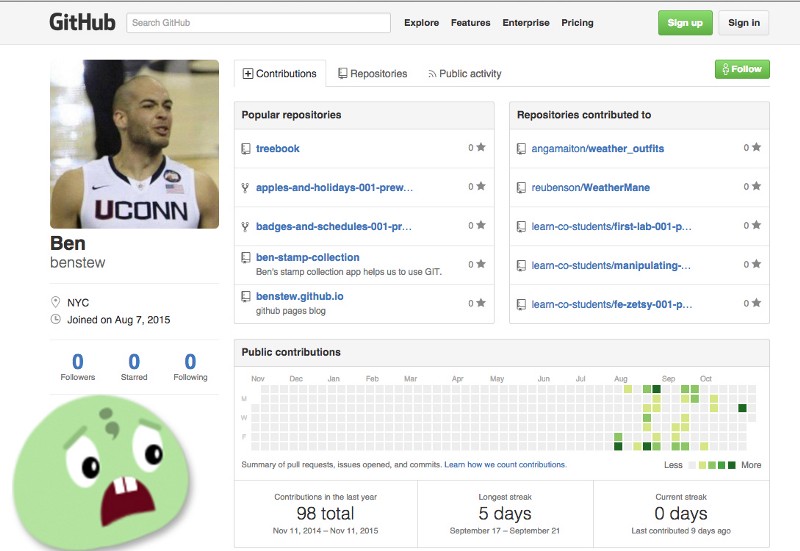Growth Hack Lessons: 5 Ways to Present Yourself to Tech Employers

This blog is part of a continuous series that highlights experiences, insights, and tutorials from learning developers at Flatiron School in Web and iOS.Disclaimer: I don’t work in HR/Placements. I don’t even have a job. Hailing from a career in finance, I was constantly entangled in the world of expensive suits, even more expensive watches, and […]
This blog is part of a continuous series that highlights experiences, insights, and tutorials from learning developers at Flatiron School in Web and iOS.Disclaimer: I don’t work in HR/Placements. I don’t even have a job.
Hailing from a career in finance, I was constantly entangled in the world of expensive suits, even more expensive watches, and the belief that it’s not about what you know but who you know.
It can be pretty overwhelming to think that so much of your success is dependent on your network, but it’s true. Tackling problems, receiving advice, and getting what you want is much easier with the right connections. And currently, the biggest problem that I have, is the fact that I will be entering the job market in just over one month and I need to stand out from my peers to get my dream job. But how??

Hell, finding any job is very hard but finding a “dream” job definitely kicks things up a notch. Looking to start a career in technology is no easy task and it is absolutely crucial that you view yourself how an employer would view you. I figured I would touch on three main concepts that are extremely important for any potential tech employee:
-
Your Network
-
Your GitHub
-
Your Muse
Network, Network, Network
Networking must become a habit. This will allow you to become very good at it with the eventual goal of being able to do it subconciously. There are opportunities everywhere and you never know what you might need in the future, so take full advantage of meeting new people and building on the relationships you already have. And when I say that you should network, I don’t mean that you should randomly friend people on LinkedIn or Twitter in hopes that they will give you a job.
Take a targeted approach that aims to build meaningful connections in your desired niche. It is amazing how many people are willing to answer your questions and even grab a coffee just because you want to know more about their experience. Don’t be scared, just be prepared and show that you can add value.
Github 101
FYI, if you aren’t aware, GitHub puts all of your code on a silver platter for anybody to see. This is somewhat of a double-edged sword because it allows you to showcase all your awesome work but without utilizing/knowing the full power of this platform, it can leave a rather unsavory taste in the mouth of a hiring manager.
After feeling confident about my presence on LinkedIn, I wanted to see how everything looked on my GitHub account. I have been intensively learning to program over the past seven weeks and I assumed that my profile would mimic all the effort that I have devoted to my craft…but unfortunately it came up slightly short. Below is a screenshot of my GitHub homepage as an employer would see it. No followers, less than 100 contributions, and a pixelated photograph led me to question my mere existence.

After picking myself up from my self doubting free fall, I thought about ways that I could leave a better impact. I created a nice little two step process that I plan on using over the next few weeks to boost my presence on GitHub.
#1 GitHub Helper Method: Embrace open source projects
Participating in open source projects allow you to practice your skills with real world applications by working on something that you genuinely care about. From a recruiters standpoint, this shows passion, growth, and that you are serious about becoming a better developer and you are willing to do whatever it takes to get there. It will also help to boost your total contributions which will make you look like a total boss in front of any prospective employer, girlfriend/boyfriend, or parent. A great website for finding open source rails projects is http://www.opensourcerails.com/ or just Google around.
#2 GitHub Helper Method: Distinguish yourself
All developers are busy, I get that. But it is important to take pride in your code. Embracing open source projects is a great first step but you need to follow that up with quality code that has a lasting impact. Don’t just participate in a project because you think it will get you hired. Add value to the project and remember to give yourself credit where credit is due. There is no shame in saying that you built that sweet auto-complete search box on the homepage. Add value and be proud!
Find your muse
A muse has to inspire you on a deep level, so I suggest you find what makes you happy and what topics you are extremely excited to learn more about. This could be education, UX, finance, analytics, sports, and the list goes on and on.
I have become increasingly interested with artificial intelligence over the past few weeks and I have spent numerous hours learning more about these principles and ways that I could potentially apply them to my projects. This has really allowed me to see all the possibilities and keeps me hungry towards reaching my highest potential as a developer.
There are so many amazing open courseware platforms available like https://www.edx.org/ and http://ocw.mit.edu/index.htm that make learning anything super accessible. Your muse will help guide you through your career and help to ensure that you are always learning about something you care about. You can then chain a couple of these ideas together and then contribute to an open source project that could be aligned with your muse. The possibilities are endless!

A great network, an awesome GitHub, and a muse will not guarantee a job, but it will keep you on track for whatever your end goal might be. Best of luck to all (including myself).
This post originally appeared on Ben Stewart's blog. Read more at Ben Stewart on Medium.
Disclaimer: The information in this blog is current as of November 25, 2015. Current policies, offerings, procedures, and programs may differ.



